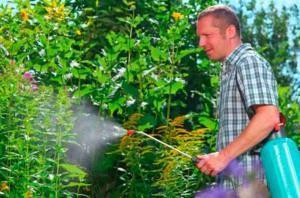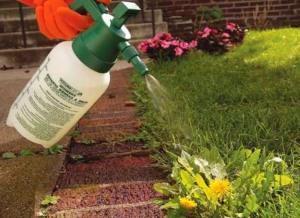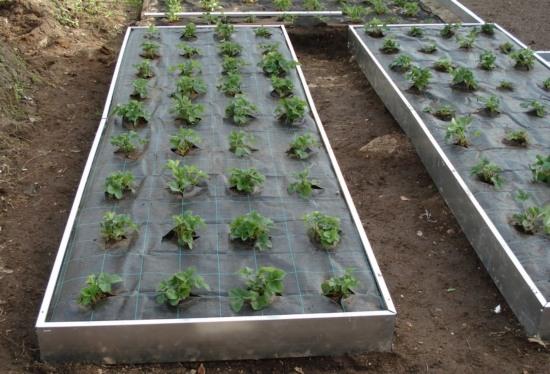Weeding, herbicide application and mulching are modern ways to control weeds in the garden
 The damage that weeds cause to the garden is known to everyone who is engaged in agriculture. They take away water, essential nutrients and sunlight from the vegetables, berries and spicy herbs grown by the gardener. In addition, weeds often harbor a variety of pests, microorganisms and diseases. For example, wild onions can become a carrier of viral diseases that are dangerous for onions, and quinoa contributes to the spread of such a dangerous disease as late blight. How can we reduce the damage caused by weeds? How to deal with weeds on the site? Are there any secrets of seasoned gardeners that help to cope with the misfortune?
The damage that weeds cause to the garden is known to everyone who is engaged in agriculture. They take away water, essential nutrients and sunlight from the vegetables, berries and spicy herbs grown by the gardener. In addition, weeds often harbor a variety of pests, microorganisms and diseases. For example, wild onions can become a carrier of viral diseases that are dangerous for onions, and quinoa contributes to the spread of such a dangerous disease as late blight. How can we reduce the damage caused by weeds? How to deal with weeds on the site? Are there any secrets of seasoned gardeners that help to cope with the misfortune?
Ways to control weeds in the garden
- Mechanical - weeding a vegetable garden, beds and row spacings with a hoe or cultivator;
- the use of herbicides;
- mulching.
Weeding
Important! Never feed the animals with weeds removed from the garden, since the seeds of some weeds are very tenacious and are able to germinate even after they are eaten by livestock, passing through the digestive tract and exiting with waste products.
Weeding after rain or watering gives the best results. This is due to the fact that it is much easier to remove weeds from wet soil without damaging the cultivated plants.
There are a few basic rules for effective weeding:
- The depth of mechanical tillage in weed control in the garden depends on the location of the root collar (ground or underground) and the shape of the weed root system. For example, plants with roots that go to great depths, such as pigs, bindweed, horse sorrel, plantain, are recommended to be dug up by the root; this procedure is performed with a shovel or a hand grubber. Grasses creeping on the ground, as a rule, have branched, shallow roots; they can be removed by deepening the hoe 2–3 cm into the soil.
- All cut and dug out weeds must be removed from the garden immediately. some of them are able to take root again - garden purslane, stellate, etc.
- Weed control in the garden should be carried out in a systematic and regular way, and not occasionally.
- You should weed not only the beds, but also areas near hedges, paths and agricultural buildings.
How to control weeds on the site using herbicides?
Advice! Before starting processing, check the lunar calendar. Sprayed on the aerial part of the plant, preparations are best applied on the waning moon. At this time, the sap of the plant moves from top to bottom, from the leaves to the roots, which contributes to the best distribution of the product.

- Roundup.
A widespread continuous-acting drug, a systemic herbicide. Affects young shoots and leaves, has a weak soil activity. - Tornado.
A drug with a broad spectrum of action. It processes the above-ground part of the plant, then, having got through the stems and leaves, it spreads and enters the root system, while the weed dies entirely.Treatment with this drug gives excellent results for fighting even such malicious aggressors as wheatgrass, pig, bindweed, and reed. - Hurricane Forte.
Postemergence, non-selective herbicide. It is used for the complete elimination of perennial and annual weeds. - Glyphos.
An aqueous solution, the main component of which is glyphosate. Blocks the synthesis of amino acids in the plant, thereby preventing it from developing.
Mulching
A simple and effective way to control weeds in the garden, this method allows, with minimal physical costs, not only to restrain the growth of unwanted plants, but also significantly improve the land, and also retain moisture.

Mulching products:
- covering - various films (lutrasil, polyethylene) and non-woven materials;
- chopped bark;
- cardboard, sprinkled on top with peat, humus or unblown lawn grass.
Important! The mulching film should not let light through, otherwise the weeds under it will feel great, like in a greenhouse.
Operating principle
The selected type of mulch is distributed over the area, preventing sunlight from reaching the soil. In film and non-woven coatings for cultivated plants, cruciform slots are left. Thus, even perennial weeds with a powerful root system are gradually destroyed.
My garden is very littered with all kinds of herbs. The fact is that for the autumn warming of the roots of tomatoes and cucumbers in the greenhouse, we bring the old hay of the last year from the farm, and there are plenty of seeds in it. Since spring, you have to sit on the beds, the field by hand. And every week I pass the aisles with a Fokin flat cutter and leave the grass to dry, the mulch turns out. I destroy the noxious weed of sow thistles with Roundup, and I cultivate the grass behind the plot with a Tornado. Very good helpers, effectively destroys all weeds. If they get on cultivated plants, the effect will be the same.
thanks for the info
Please advise how to get rid of such a weed on the lawn (I think it is a wild onion) the lawn is very large and by digging it is a laborious work. Little kids onions filled the entire site. Weed teaches me what to do. Maybe there are some chemicals to use, there are no cultivated plants close. Please wait for an answer. Thank.
Why get rid of it? Many people specifically buy and plant this plant, because this is a relative of hyacinth - ornithogalum or poultry farm. After all, the bushes bloom in late spring with white asterisk flowers? For their unusual shape, the plant is also called the Bethlehem or milk star. And if you treat it with the drug, then the lawn will no longer be - both the flower and all the grass will disappear, and bare earth will remain.